Coronavirus – the chinese are coming, they’ll change tourism for ever and covid-19 will not stop them.
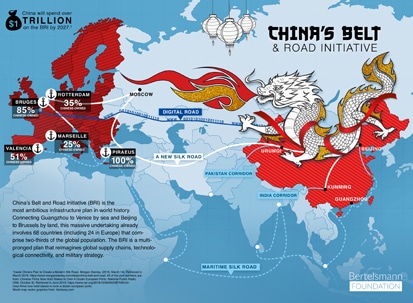
Picture – Bertelsman Foundation
The New Silk Road is China’s tourism route to unprecedented global economic power and political influence.
By October 2049 the world of tourism will have dramatically changed. China will have seen to that.
By the hundredth anniversary of the People’s Republic of China, the massive economic area free trade zone envisaged by the ‘Belt and Road’ scheme – will come into full operation as forecast.
Extending all the way from inner China to the heart of Europe, Chinese high-speed trains are bringing avid travellers to stay in Chinese branded hotels, to buy Chinese manufactured goods and souvenirs and to eat Chinese foods.
In 2019 China World Number 1 in outbound tourism with around 200 million international travellers a year. By 2049 at the present rate of growth the figure is likely to be more like 600 million up to maybe a billion.
Ultimately COVID-19 will not change that at all. Generally the Chinese that travel are well off and in search of unique experiences they can only get in the West. Moreover as Coronavirus has spread from China which currently has far the greatest numbers of cases – a visit to the west could be seen safer than a visit in China – especially for those Chinese that already have immunity. When travel bans are lifted, Chinese tourists are ready to rock.
These travellers will have billions to spend and you can be sure that China’s centrally-managed tourism will make sure that it is spent where China wants it to be spent.
The Chinese government calls the massive Belt and Road initiative "a bid to enhance regional connectivity and embrace a brighter future". Cultural and economic initiatives are merged in tourism and the Silk Road tourism initiatives will certainly be geared to Chinese tastes.
There have already been plans for major Las Vegas-style casino cities and winter sports centres in and around Kazakhstan and there will certainly be more.
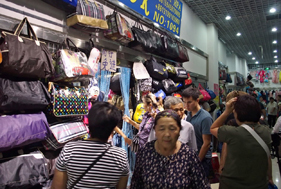
A new Chinese duty free zone in Kazakhstan
The entire vast Silk Road system will be interconnected in economically-protected tax haven free trade zones. Through China, Kazakhstan, Tajikistan and Uzbekistan all the way to Hungary and Europe. To the US via the North Silk Road and Africa via the South This is also likely to bring to the fore historic Silk Road Cities (of which there are hundreds) such as Samarkand, Kabul, Shiraz, Almaty, and many more. Add to these the many destinations in South East Asia and this adds up to truly colossal economic power.
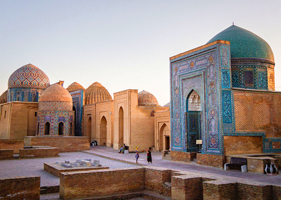
Samarkhand
The initiative calls for the integration of the region into a cohesive economic area through building infrastructure, increasing cultural exchanges, and broadening trade. Apart from this zone, another area that is said to be included in the extension of this ‘belt’ is South Asia and Southeast Asia. Many of the countries that are part of this belt are also members of the China-led Asian Infrastructure Investment Bank (AIIB). North, central and south belts are proposed.
The North Belt would go through Central Asia and Russia to Europe. The Central Belt goes through Central Asia and West Asia to the Persian Gulf and the Mediterranean.
The South Belt starts from China to Southeast Asia and South Asia, to the Indian Ocean through Pakistan. The Chinese One Belt strategy will integrate with Central Asia through Kazakhstan’s Nurly Zhol infrastructure program.
The Silk Road Land Corridors:
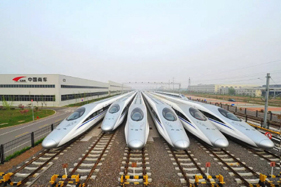
Chinese high speed trains await
The New Eurasian Land Bridge runs from Western China to Western Russia through Kazakhstan and includes the Silk Road Railway through China’s Xinjiang Autonomous Region, Kazakhstan, Russia, Belarus, Poland and Germany.
- The China-Mongolia-Russia Corridor will run from Northern China to the Russian Far East. The Russian government established the Russian Direct Investment Fund and China Investment Corporation, a Chinese government investment agency, partnered in 2012 to create the Sino-Russian Investment Fund, which concentrates on potentially huge opportunities in bilateral integration.
- The China-Central Asia-West Asia Corridor will run from Western China to Turkey.
- The China-Indochina Peninsula Corridor will run from Southern China to Singapore.
- The Bangladesh-China-India-Myanmar (BCIM) Economic Corridor runs from southern China to Myanmar and is officially classified as "closely related to the Belt and Road Initiative".
- The China-Pakistan Economic Corridor (also known by the acronym CPEC), also classified as "closely related to the Belt and Road Initiative" is a US$62 billion collection of infrastructure projects throughout Pakistan that aims to rapidly modernise Pakistan’s transportation networks, energy infrastructure and economy. On November 13, 2016, CPEC became partly operational when Chinese cargo was transported overland to Gwadar Port for onward maritime shipment to Africa and West Asia.
Maritime Silk Road
The "21st Century Maritime Silk Road" is a complementary initiative aimed at investing and fostering collaboration in Southeast Asia, Oceania, and North Africa, through several contiguous bodies of water: the South China Sea, the South Pacific Ocean, and the wider Indian Ocean area.
Like its sister initiative the Silk Road Economic Belt, most countries in this area have joined the China-led Asian Infrastructure Investment Bank.
Ice Silk Road
In addition to the Maritime Silk Road, Xi Jinping also urged the close cooperation between Russia and China to carry out the Northern Sea Route cooperation to realize an "Ice Silk Road" to foster development in the Arctic region. China COSCO Shipping Corp. has completed several trial trips on Arctic shipping routes, the Transport departments from both countries are constantly improving policies and laws related to development in the Arctic, and Chinese and Russian companies are, perhaps alarmingly, seeking cooperation on oil and gas exploration in the area and to advance comprehensive collaboration on infrastructure construction, tourism and scientific expeditions.
East Africa
In May 2014, Chinese Premier Li Keqiang visited Kenya to sign a cooperation agreement with the Kenyan government. Under this agreement, the Mombasa-Nairobi Standard Gauge Railway was constructed connecting Mombasa to Nairobi. After completion, the railroad stretches approximately 300 miles (480 km) costing around $250 million USD.
In September 2015, China’s Sinomach signed a strategic, cooperative memorandum of understanding with General Electric. The memorandum of understanding set goals to build wind turbines, to promote clean energy programs and to increase the number of energy consumers in sub-Saharan Africa.
Hong Kong
During his 2016 policy address, Hong Kong’s last chief executive Cy Leung announced his intention of setting up a Maritime Authority aimed at strengthening Hong Kong’s maritime logistics in line with Beijing’s economic policy. Leung mentioned "One Belt, One Road" no fewer than 48 times during the policy address, but details were scant.
These are just a few of the hundreds of mega-million dollar initiatives. There will certainly be more.
China is already the world’s Number 1 tourism source market, it is unlikely that this position will change for the foreseeable future, particularly given the fact that it is forecast that up to 3 billion Asian residents will become middle class by 2050.

The city of OZ was scheduled to have no less than 48 casinos in Kazakhstan
Already the power of Chinese tourism is having a major effect on the Silk Road countries. For instance around Lake Baikal in Siberia there is local agitation as Chinese people continue buying up property; near Almaty in Kazakhstan a major tourism development is taking place to attract Chinese to gamble and relax; also in Kazakhstan a mass tourism ski development is being created to attract Chinese skiers.
It is a short step to Chinese-branded hotels, restaurants, shops and other Chinese-run businesses all along the Silk Road, even to Germany and Italy. It is an even shorter step to Chinese centrally-organised tourism taking place from China to the Mediterranean.
Furthermore, China will own land, railways, ports and duty-free shopping centres all along their road. The fact is: they already do.
The benefit to China? Wielding quasi-global economic and political power through outbound tourism. While it may remain a marginal phenomenon in demographic or trade terms, tourism is a crucial issue in contemporary China, a major object of governmentality and a means to push soft power initiatives to receptive countries.
China exercises soft power using outbound tourism (and arts and culture more broadly), in their soft power play.
Tourism has also been used to enforce the construction of borders and boundaries in the South China Sea, leading to rising tensions.
Just as many countries have eased their visa requirements for Chinese tourists, China has increasingly sought to police ‘low-end’ tourists who might undermine the Chinese authorities as they attempt to boost their influence on the international stage. The authorities have sought to attract members of the overseas Chinese community to China through Root-Seeking Tour Summer Camps, organized by the Overseas Chinese Affairs Office of the State Council, so as to teach the Chinese language and culture.
Questions have begun to emerge about the linkages between tourism and politics, tourism and human rights, tourism and international migration patterns, and the impact of returning Chinese tourists on Chinese society.
These questions place the global significance and impacts of Chinese tourists into a broader context. Chinese media increasingly highlight the growth of outbound tourism to particular counties, potential revenue and links to the Belt and Road Initiative.
While pitched as tourism projects, China has been accused of hiding its search for political, economic and military influence through tourism. As tourism projects embed infrastructure that supports the development of trade routes (global network of railways, roads, ports, pipelines, fibre-optic cables), does Chinese investment bring wealth, or will it be mainly kept within a closed loop of overseas Chinese communities and state-linked businesses?
In Forest City, Johor Bahru (Malaysia), Chinese tourists are encouraged to buy Chinese-built apartments in a US$100 billion development designed to include international schools, shopping malls, hotels and an immigration centre for approximately 700,000 Chinese residents.
The construction of the $1.4bn (£1.1bn) Port City project in Sri Lanka by the state-owned Chinese engineering firm China Communications Construction Company (CCCC) on 665 acres (2.6 sq km) of land is been marketed as "a new Dubai, with luxury hotels, shopping malls and a marina."
While China pledges that the New Silk Road will be open, transparent and environmentally friendly, many of these projects appear to lack transparency and accountability. There are concerns that the standard 99-year leases for these projects will lead to social, economic and environmental challenges, such as opaque funding, exorbitant claims regarding their tourism potential, corruption, and population displacement.
Questions are emerging over the differences between these projects and the past and current ones dominated by the West.
While the New Silk Road spans 65 different countries, Chinese tourism, more broadly, holds the potential to redefine the international industry, infrastructure, economies and even the governance of many more countries, as Beijing establishes its own norms, rules and institutions.
Valere Tjolle
Valere is the author of ‘You Lucky People’ the story of travel – the world’s most delightful and devastating industry. Find out more about it HERE
 United Kingdom
United Kingdom United States
United States Asia Pacific
Asia Pacific







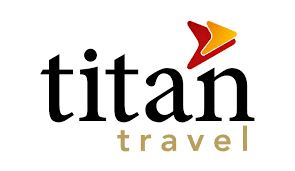


























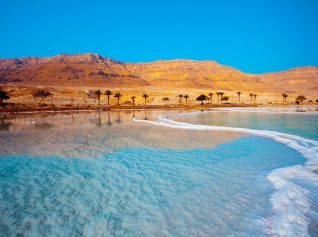

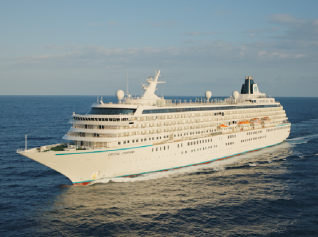







BA suspending all Heathrow to Abu Dhabi flights
Turkish Airlines flight in emergency landing after pilot dies
Unexpected wave rocks cruise ship
Woman dies after going overboard in English Channel
Foreign Office issues travel advisory for winter sun destinations